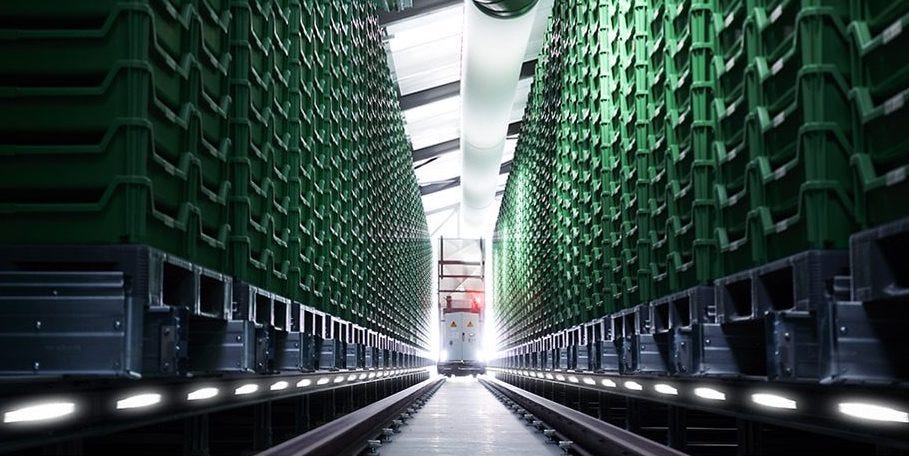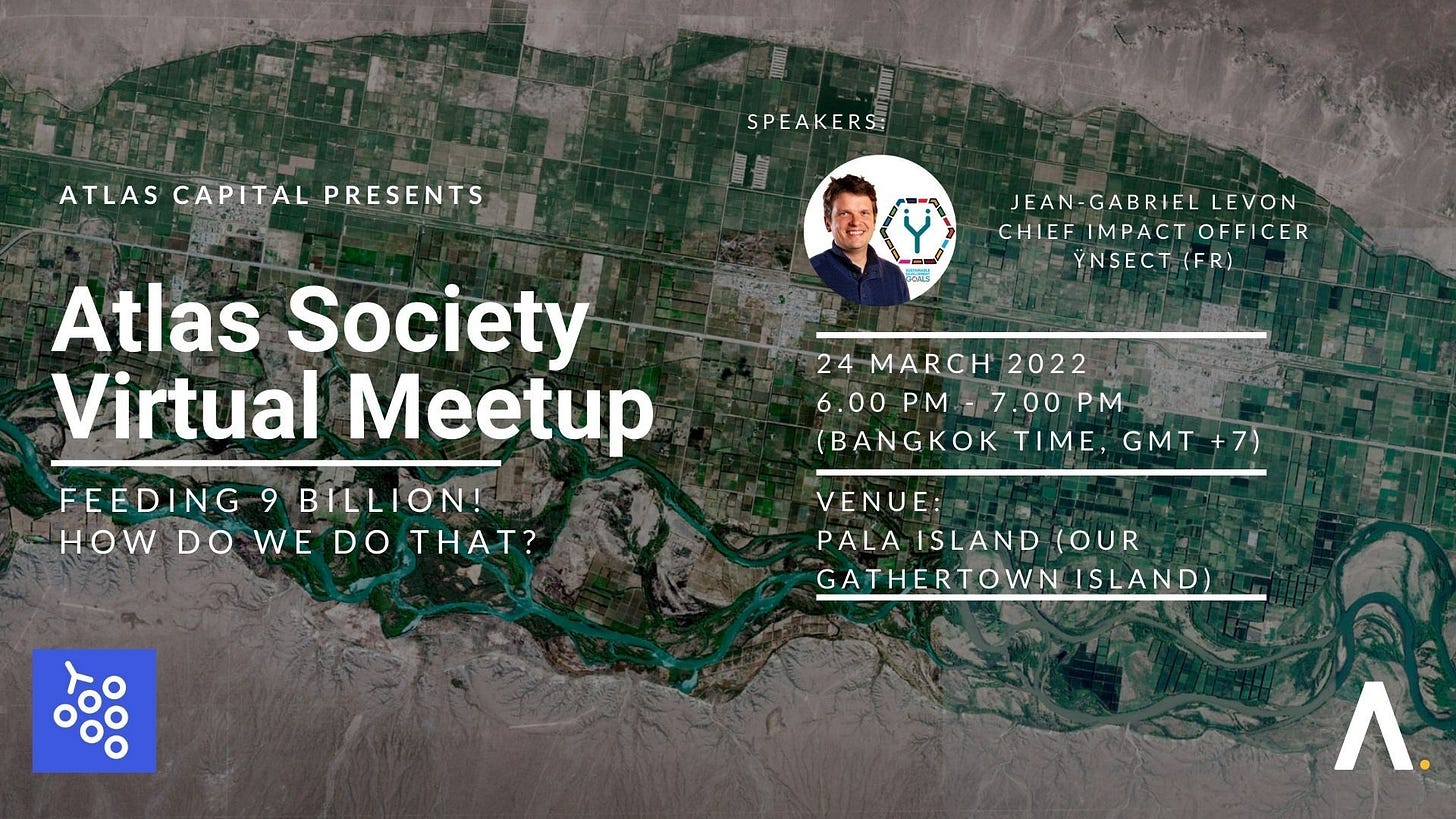Feeding 9 billion... How do we make it work?
Is it even possible to imagine that many people on a single ship? If WW3 doesn't happen by 2050 and birth control isn't an option: we researched for you some interesting solutions in the making...
By 2050, the world population is expected to reach 9.7 billion from 7.9 billion in 2022. Each of them needs about 1.4 kilograms of food on average per day. Currently, we require 4 billion metric tons of food a year and that number is expected to reach 5.1 billion metric tons a year. Food scarcity will become an even larger problem than before, especially in Sub-Saharan Africa where water remains scarce.
The global food supply will also be under strain as food production is responsible for 26% of total greenhouse gases emission while laws are being passed to reduce the emission. Transportation of food to urban areas also proves a challenge as long-distance transportation makes food, (yes, vegan as well), carbon-heavy. Our mission at Atlas Capital is to search for alternatives and solutions that will increase food output and reduce food wastage while making food production and transportation more sustainable.
Thriving with Diminishing Resources and GHG reductions
There is nothing new about the grim prediction of global starvation, where the food supply will not be able to keep up with population growth. In 1798, an English economist, Thomas Malthus, argued that population increases exponentially while food production increases gradually. The ensuing result is the catastrophe of war and famine which will lead to poverty and depopulation. Thankfully, Malthus was wrong. Since the mid-17th century, the agricultural yield had been increasing tremendously. This period is called “the Agricultural Revolution'', where new technological innovations and methods boosted labor and land productivity. Farmers practice crop rotation to reduce soil erosion and improve soil nutrients. Tools, such as plow, threshing machines, and seed drills, also allowed farmers to cultivate more crops for higher yields. Thus, the world avoided the catastrophe. However, the problem did not end then as, without a global-scale birth control system, the human population grew exponentially and is heading towards a scary 9 billion by the end of the next decade. So, aside from birth control, if we want to ensure our children access food security in a zero-carbon world, there are surely some innovations to be made and deployed globally.
Let’s first understand the limits of the current food system and then dig into some interesting solutions we have found as part of The Adaptive Economy.

Food production is responsible for 26% of greenhouses emissions, more than our electricity production. As the world is trying to achieve carbon neutrality in 2050, food production will be subjected to even more restrictions to reduce emissions. For example, fertilizer will be controlled such that it will produce less nitrogen oxide and the agricultural machinery will use electricity instead of fossil fuels. This will be a large problem, granted that the demand for food will continue to grow due to the rapid population growth.
Agricultural practice
Agriculture leaves a larger carbon footprint than many imagined. In order to cultivate a piece of land, forests have to be cleared. When forests were cut or burned down, carbon emissions in the atmosphere increase. It is estimated that 2.9 billion metric tons of carbon dioxide (8% of global emissions) originated from deforestation in 2018. After the reaping season, farmers also burned organic soil to clear the land for the next crop season. The burning of soil released 1 billion metric tons of carbon dioxide (2.7% of global emissions) in 2018. The massive emissions mentioned here do not include the use of chemical fertilizers which release toxic waste into the rivers and then into the phreatic zones.

The problems with livestock
According to the University of California, Davis, livestock is responsible for around 14.5% of global emissions annually, including the methane released by animals, land usage, and animal feed. Cattle livestock raised both for beef and dairy products, produce the most emissions among all species (65% of livestock emissions). Currently, the large amount of emissions is attributed to inefficient breeding, feeding, and processing of this livestock. Furthermore, per kilogram of yield, meat and animal products require the most amount of water (15,415 l of water per 1 kg of beef vs 322 l of water per 1 kg of vegetables). Without any significant innovations in the livestock industry, not only the emissions will continue to increase, but the scarcity of water will also become a problem for many countries.
Transportation and Storage of Food
Transportation of food also contributed to the rising global GHG emissions. Food miles measures how far a food item has traveled from its source to the consumer. While transportation only accounts for 11% of the total emission from food production, it will become more difficult in the future as lands become less arable and countries have to look to imports for food. Food items, especially delicacies found only in a specific region, leave the highest carbon footprint. Additionally, FAO estimated that 14% of food produced is lost through storage and transportation. This greatly increases the emissions that yield no food output. The refrigeration of food during transportation also uses a large amount of electricity, further adding to the emissions. We have to find a sustainable and efficient solution to how we transport the food across the globe.
Common natural disasters
Another problem is the higher likelihood of violent natural disasters occurring. Firstly, the rising temperature has made agriculture more difficult. Crops and fruits that are sensitive to a fluctuating temperature usually yield small fruits or none at all. There is also an ongoing water crisis as 785 million people around the world still lack access to clean water. This is alarming as 2 quadrillion gallons of water, or 70% of the world’s water, are used in agriculture. With the increased occurrences of severe droughts and shortage of water, agriculture and food production need to become more efficient with diminishing resources.
Solutions for a Resilient, Adaptive Agricultural Revolution
Entrepreneurs and investors around the world have already mobilized to solve this problem. The market for innovations in Food & Water Industry is huge. The Commission on Sustainable Agriculture Intensification suggested an annual investment of USD 15.2 billion in agricultural innovations to reach critical Sustainable Development Goals (SDGs), and it seems like there is some hope with brilliant people working days and nights to re-invent how we eat, on a more sustainable way.
Here are some interesting innovations we have found:
Nitricity produces fertilizer in a revolutionary way, using just air, water, and renewable electricity. The global supply of fertilizer is not sustainable and is fuelled by coal and natural gas. Additionally, fertilizer distribution is an inefficient and expensive process involving transportation over thousands of miles. Traditionally nitrogen fertilizer has been produced as ammonia in facilities and is responsible for 1.6 percent of global carbon dioxide emissions.
Nitricity’s ground-breaking green technology produces nitrogen fertilizer at or near the point of use massively cutting down on transportation costs whilst also drastically reducing the carbon footprint involved in the production, transportation, and application of nitrogen fertilizer.
Ynsect is providing an alternative to protein for animal feed and aquaculture by utilizing insects. Today, 50% of the fishes we eat come from aquaculture, and 60% of the fishes produced in these fish farms are actually used to feed other fishes. This does not make sense. Ynsect believes bugs farming is more sustainable than any other form of animal feed source due to the high protein output with low water and energy input needed to grow tons of insects. Funded by Robert Downey Junior and other big bucks from Silicon Valley, they are the unicorn building the largest insect farm in the world.
Agriloops is an aquaponics startup re-inventing aquaculture by spearheading the adaptation of saltwater into aquaponics in France. The startup is developing saltwater aquaponics: a circular system in which prawns and vegetables grow together. This innovative technique allows for the maximization of sustainability by recycling polluting effluents from shrimp to use as fertilizer. Crustacean waste is transformed into fertilizer for growing plants such as cherry tomatoes and aromatic herbs, which are cultivated in an above-ground and less water-intensive way.
This week, we have a chance to interview Agriloops, a French company building an aquaponics farm for shrimps. Watch the highlight from the interview below:
With these technologies, the future is not as bleak as predicted by many. By focusing funding on vital sustainability tech innovations for food production, at Atlas Capital, we look for innovative and sustainable solutions to world hunger and the growing population.
PS: Like Nitricity, Agriloops, Ynsect… Atlas Capital’s deal flow now includes nearly 100 early-stage sustainability tech companies in which you can invest and be part of their pre-IPO journey. If interested to co-invest, contact us to receive the deal flow: djoann@theatlascapital.com
Connecting Agritech entrepreneurs with investors
On the 24th of March, Atlas Capital will be organizing a meetup on Pala, our virtual private island. We have invited entrepreneurs experts in sustainable food production to share with us their plans to incorporate sustainability into their industry.
Alongside these entrepreneurs designing the world we are about to live in, we will gather investors ready to support building this new world by investing in startups and venture capitals.
Alternatively, if you can’t make it, you can still follow our Linkedin Page where we share insights, events and interview entrepreneurs, corporates, and investors working on emerging sustainability tech solutions to save our planet while reinventing how we live, carbon-free.
Sources, sources, sources, sources, sources, sources, sources,







